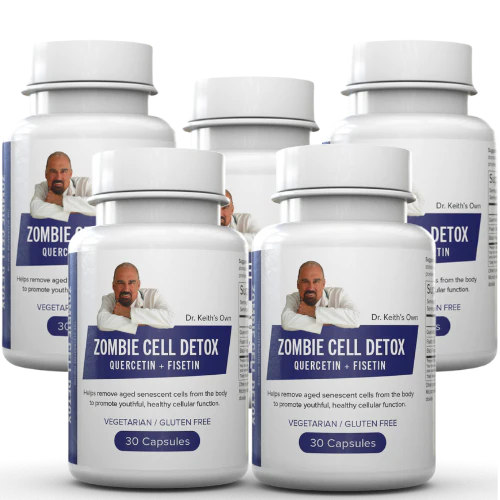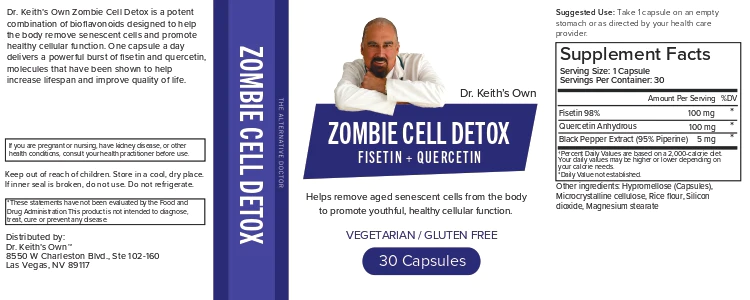Zombie is a popular buzzword these days. There is a TV show dedicated to Zombies: The Living Dead! But what is a zombie? A creature (usually human) that is more dead than alive. It walks, it talks, it howls… but it doesn’t think!
According to NBC television, Zombies are worth $5 billion a year to the economy!
Doctors and scientists have co-opted the term (jokingly) “zombie cells” to mean aged, senescent cells in our bodies that have outlived their usefulness: they are more or less dead. So, is that a problem?
Well, it turns out it’s a very big problem. Senescent cells are aged cells that stop functioning properly and can cause damage to surrounding tissues. They lose the ability to grow or divide, and yet they refuse to die off, so they are a bit like “zombie cells.”
It’s worse: these senescent cells spew out compounds that incite harmful systemic inflammation, inflicting even more damage. Senescent cells are a major driver of age-related disease and dysfunction. They even accelerate the aging process itself. [Dodig S, Cepelak I, Pavic I. Hallmarks of senescence and aging. Biochem Med (Zagreb). 2019 Oct 15;29(3):030501].
The Dracula Experiment
This is shown by the fact that if we take the blood of young animals and inject it into senile animals (you can’t do this with humans; shades of Dracula!) the older creatures are rejuvenated and act much younger.
That means either there is a “youthful” factor being transferred. Or there is a “senile” factor that is being diluted. It turns out to be the second of the two. As we get older, we accumulate “agedness” factor in the blood. It turns out this senility factor is old and dying cells. If we can remove them, we feel rejuvenated and healthy again.
It doesn’t need blood transfers. We get the same happy result when we do fasting and keto. Keto triggers the removal of aged “zombie” cells, eaten up by macrophages, a process called autophagy (literally: eating self in posh old Greek). This process is sometimes called “cellular housekeeping.”
As a result, we feel vibrant, energetic and healthier than before. We also, coincidentally, get a rush of stem cells too, ready to go to work restoring and repairing the body’s tissues.
That’s why I highly recommend intermittent fasting and keto. BUT IS THERE AN EASIER WAY? Oh, you bet!
There are nutrient compounds called senolytics (posh Greek for age dissolvers). A number of these have been studied and some are really good at “zombie detoxing”, shall we call it!
Check Wikipedia and it says this: A senolytic is among a class of small molecules under basic research to determine if they can selectively induce death of senescent cells and improve health in humans. A goal of this research is to discover or develop agents to delay, prevent, alleviate, or reverse age-related diseases.
The first senolytic substances studied were Dasatinib, Quercetin, Fisetin and Navitoclax. Here I’m going to focus in on Fisetin. Why? Because I’m selling it, silly! Just read on…
Fisetin
Fisetin really is the finest thoroughbred horse in the senolytics stable, destroying dysfunctional senescent cells and extending lifespan by approximately 10% in animal studies.
It is a plant flavonol from the flavonoid group of polyphenols. These are a hot anti-oxidant group of compounds! Fisetin can be found in many fruits and vegetables, where it serves as a yellow/ochre coloring agent, such as in strawberries*, apples, persimmons, onions and cucumbers.
According to a study published in eBioMedicine, an arm of The Lancet: “Of 10 flavonoids tested, fisetin was definitely the most potent senolytic.”
Acute or intermittent treatment of old mice with fisetin reduced senescence markers in multiple tissues. Administration of fisetin to wild-type mice late in life reduced age-related pathology, and extended median and maximum lifespan. [eBioMedicine. Volume 36, P18-28, October 01, 2018]
Here in one image is the result of taking good senolytic drugs (courtesy UK Daily Mail):
There is a lot more to fisetin than just life extension. The article went on to comment “Late life intervention [with fisetin] was sufficient to yield a potent health benefit” in both humans and mice.
Anti-Inflammatory and Other Beneficial Effects
In line with its role as a flavonol, fisetin has powerful anti-oxidant and therefore anti-inflammatory effects. According to the book Role of Flavonoids in Management of Inflammatory Disorders (Editors: Ronald Watson, Victor Preedy. 2019), fisetin “powerfully” reduced markers of inflammation, which benefitted joints and other tissues.
Another book, Regenerative Nephrology (2nd edition, 2021. Editor: Michael Goligorsky), showed that in aging mice (22–24 months), fisetin treatment decreased cellular aging in kidney, liver, fat, and spleen, and reduced levels of circulating senescence-associated secretory phenotype (SASP) factors (don’t even ask!) The mice lived 10% longer. [Yousefzadeh MJ, Zhu Y, McGowan SJ, et al. Fisetin is a seno- therapeutic that extends health and lifespan. EBioMedicine. 2018 Oct;36:18-28].
Fisetin even has a role against cancer, according to a Science Direct review. It helped induce cellular apoptosis (programmed cell death), alone and in conjunction with a chemo-gent: cisplatin. This was against deadly lung cancer cells, so that could be important to many of us. [https://www.sciencedirect.com/topics/medicine-and-dentistry/fisetin]
A 2014 study described various flavonoids, such as apigenin, baicalein, cyanidin, fisetin, galangin, hesperetin, luteolin, myricetin, naringenin, phloretin and quercetin, as quite potent inhibitors of DNA methyltransferase activity (that’s good—tumor cells typically exhibit aberrant DNA methylation patterns during malignant transformation)
[Zhang, W., Xu, J. DNA methyltransferases and their roles in tumorigenesis. Biomark Res 5, 1 (2017). https://doi.org/10.1186/s40364-017-0081-z]
Mimicking Caloric Restriction
Reducing food intake through a calorie-restricted diet has been shown to slow aging, extend lifespan, and improve resistance to disease.
Research has identified the cellular pathways that are affected by such a diet. Among other benefits, caloric restriction: And, of course, that helps with weight loss, glucose control and, ultimately, diabetes.
There are 3 main ways that fisetin can help with weight control…
- Reduces the activity of mTOR (mammalian target of rapamycin), a remarkable substance linked to aging, weight gain, and chronic disease.
- Boosts the function of sirtuins (remember resveratrol and that story?)
- It helps flip the “fat switch” to OFF, by increasing the activity of the enzyme AMPK.
Fisetin not only has the ability to extend lifespan in preclinical models, it may also reduce the risk for many of the most common chronic illnesses.
Heart disease remains the leading cause of death in the U.S. Most common forms of heart disease are due to inadequate flow of blood, oxygen, and nutrients to the heart, which can lead to a heart attack.
Over the last two years, studies have demonstrated that fisetin can protect the heart from injury. Even after heart attack models, heart cells fare better when fisetin is present.
In one recent study published in the journal Nature, rat heart cells starved for nutrients and oxygen were protected by fisetin, preventing cell death.
And in animal models of heart attack, the extent of heart damage was reduced when treated with fisetin, preserving better heart function.
[https://www.lifeextension.com/magazine/2021/2/fisetin-senolytic-benefits]
So We All NEED Fisetin. What Next?
It so happens I have picked up a line of fisetin supplements. I’m even being given the right to use the title “Zombie Cell Detox”!
The good news for YOU, dear reader, is that you can try out this miracle substance very inexpensively. I want to test out the demand, to figure out how much I need to put into inventory.
Help me out here, guys! If you like what I’ve told you, get some Zombie Cell Detox and start taking it.
Don’t be a zombie! Stay young and vibrant until your last day on earth!
Thanks,
Prof. Keith Scott-Mumby
The Official Alternative Doctor
The post What Are Zombie Cells and How Do We Get Rid Of Them? appeared first on Dr. Keith Scott-Mumby.


